Amy Sprague
May 28, 2025
New method explains stingray skeleton architecture.
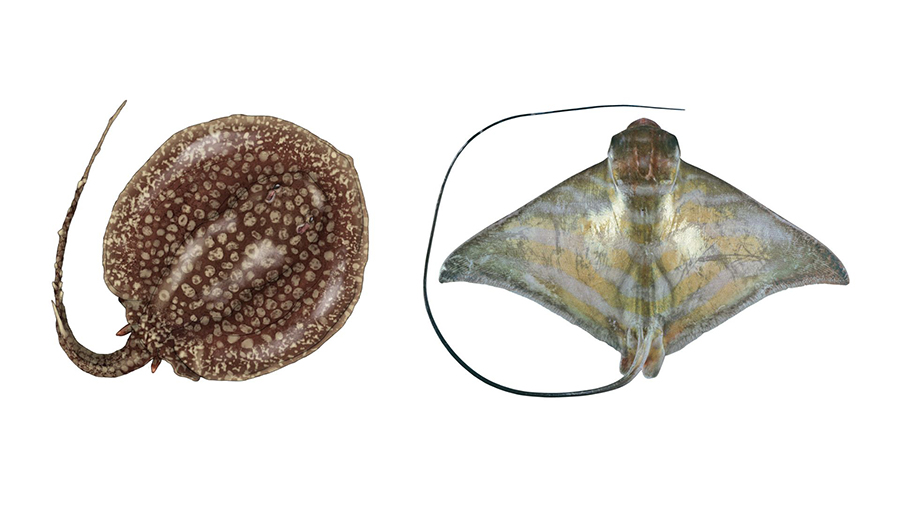
P. iwamae, the long-tailed river stingray, left; and A. nichofii, the banded eagle ray, right, the two species involved in this research.
John Michael's research shows how one curious mind equipped with innovative tools, unconventional questions, and exceptional collaborators can open entirely new pathways for discovery.”
When John Michael Racy looks at a stingray, he doesn't just see an elegant elasmobranch—he sees a wealth of tantalizing engineering challenges. The UW mechanical engineering student's research out of A&A’s Illimited Lab and the Friday Harbor Lab’s Lab 8, published in the Journal of the Royal Society Interface, is revealing how generative design can be used to analyze the complex shapes found in biological rigid structures like skeletons.
With his co-authors, aeronautics and astronautics Ph.D. student Bart Boom and Professor Adam Summers, who holds appointments in both the UW School of Aquatic and Fishery Sciences and the biology department, Racy turned to generative design to understand the complex forces that shape the elements of the stingray fin skeleton. These small elements, called radials, are made from mineralized cartilage and have evolved sophisticated forms that traditional research methods struggle to analyze.

John Michael Racy
"One of the first things I learned from Professor Summers is that when a biologist wants to understand the function of a biological structure, they approach it the same way we engineers do when designing structures." says Racy, whose research represents his first published paper. “They simplify; think beams, tubes, levers. These simplifications make the math doable, but they always reduce the fidelity to the biological reality.”
“When you look at the stingray radials, you quickly realize how little nature cares for our love of simplification.” Racy points out, “The shapes of the radials are intricate, and the loads placed on them are uncertain. We want to understand both, which means we need a new approach.”
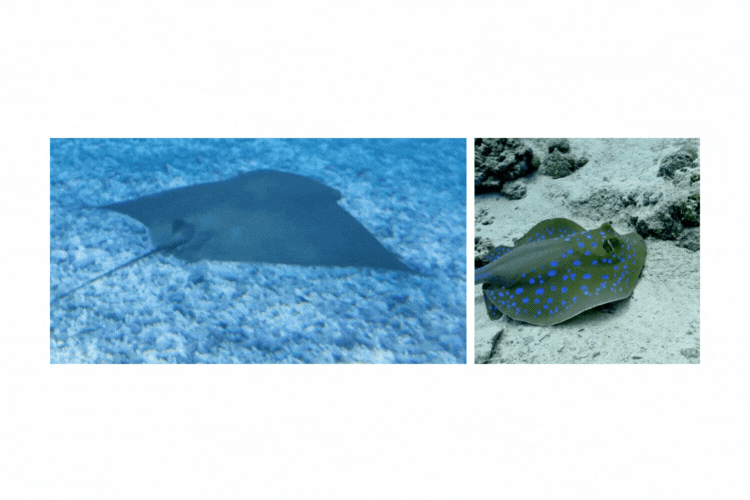
Left: A. nichofii, the banded eagle ray, is an oscillatory swimmer categorized by a simple flapping motion. Right: P. iwamae, the long-tailed river stingray, is an undulatory swimmer, categorized by the multiple traveling wave periods produced during locomotion.
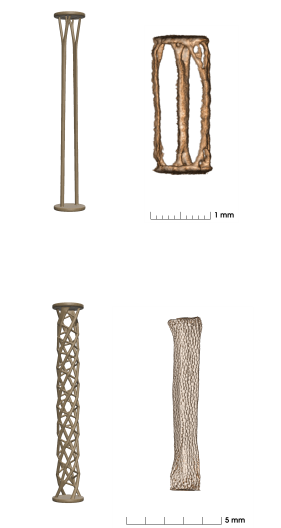
Structure created by generative design for high compressive and low torsional loads and a similar “catenated” distal radial of P. iwamae (top left and right) and a structure created by generative design for a high compressive load and a high torsional load and a similar “crustal “distal radial of A. nichofii, which faces similar torsional and load structures (bottom left and right).
That approach was generative design—an engineering tool that creates thousands of potential solutions based on defined constraints and input parameters. What emerged was remarkable: with certain geometric constraints and applied forces, the computer-generated structures looked strikingly similar to multiple types of actual stingray radials.
A&A Assistant Professor Ed Habtour, Racy's faculty adviser, sees this research as exemplifying the UW's commitment to boundary-crossing innovation. "What makes John Michael's work so significant is how it demonstrates the power of interdisciplinary thinking," says Habtour. "Engineers and biologists working together get to answer questions that engineers haven’t even thought of with tools that biologists didn’t even know existed, and vice versa. These collaborations often lead to findings with significance beyond the confines of either field."
The research specifically examined two stingray species from the collection of the UW Biomechanics Lab at Friday Harbor Labs: the long-tailed river stingray (Plesiotrygon iwamae), which uses an undulatory swimming style with multiple wave periods along its rounded fins, and the banded eagle ray (Aetomylaeus nichofii), which uses an oscillatory swimming style with a half wave period per flap of its triangular fins.
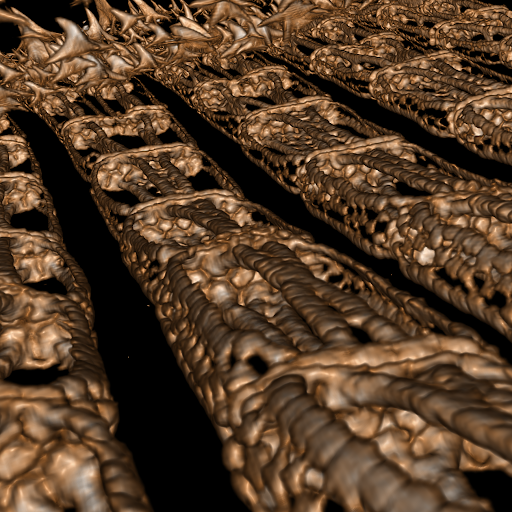
Micro-computed tomography (µCT) scan beneath the denticles of the pectoral fin of a long-tailed river stingray, P. iwamae, visualized using 3DSlicer.
Through detailed comparison, the study revealed that applying different loading combinations to the generative design model produced distinctive architectures that mirror what's found in these stingray species. Simple compression forces created structures resembling the "catenated" radials found at the tips of P. iwamae’s fins, while adding even small amounts of torsion introduced the crosslinking that appears in radials near the base of P. iwamae’s fins. Adding more torsion dramatically changed the design to interconnected networks similar to the "crustal" radials found in A. nichofii.
"This technique shows us that details that might look like random variation actually represent specialized solutions to particular mechanical challenges," concludes Racy.
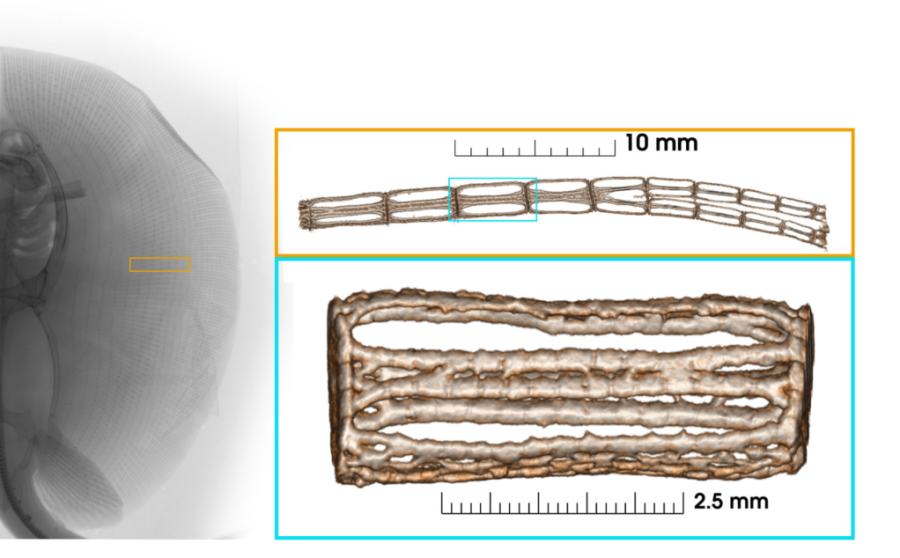
Superior radiograph of an undulatory stingray, courtesy of the University of Michigan Museum of Zoology (left). In orange box, a micro-computed tomography (μCT) scan of a section of a fin ray from P. iwamae showing the change in structure from proximal to distal radials. In blue box, an individual radial.
"This is exactly what we mean when we talk about being boundless at the UW. Our students don't just accept the limitations of their field—they actively seek ways to transcend them."
The findings offer a new tool for biomechanists to investigate hypotheses about forces that shape skeletal elements. This UW-led innovation could help scientists better understand not just stingrays, but potentially any rigid biological structure where forces and form are intertwined.
As Habtour puts it: "This is exactly what we mean when we talk about being boundless at the UW. Our students don't just accept the limitations of their field—they actively seek ways to transcend them. John Michael's research shows how one curious mind equipped with innovative tools, unconventional questions, and exceptional collaborators can open entirely new pathways for discovery."
Go to the source
“Generative design as a tool to analyse the uncertain loading regimes of intricate skeletal structures” by John Michael Racy, Bart Boom and Adam Summers, Royal Society Interface.
This research is supported by The Seaver Institute and NSF (CFDA2341950), with software provided by Autodesk Inc.
Related story
Structures research
Stingrays could inspire new underwater vehicles
A&A researchers look to stingrays for how to develop efficient, quiet and sustainable underwater vehicles.